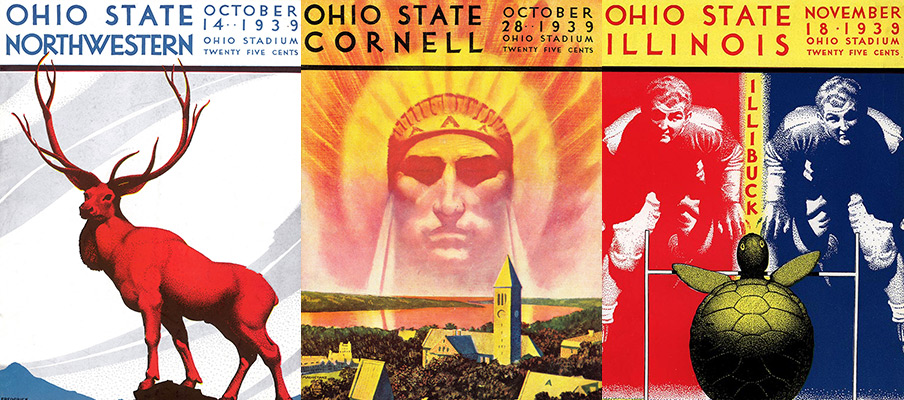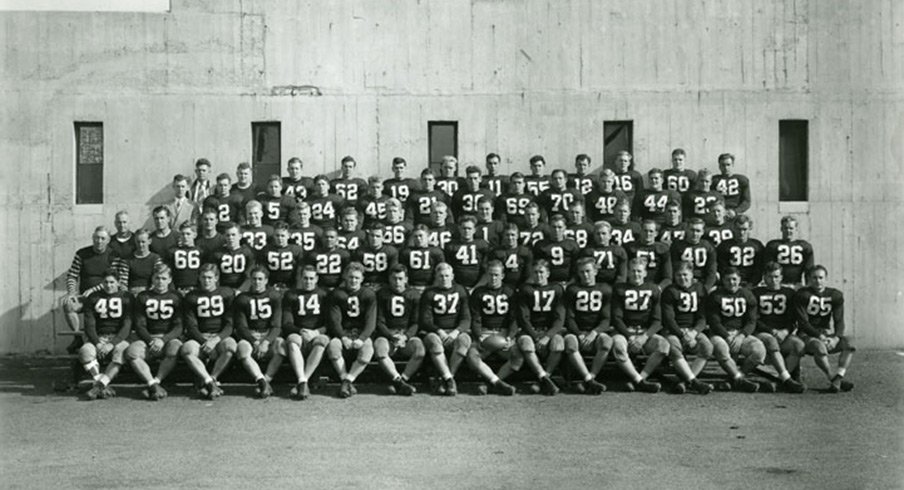Following a disappointing season in 1938, Francis Schmidt needed wins to cool his seat. He got those – and won a Big Ten championship in 1939 – but, the year was not without disappointment.
It's 1939. Ohio State is coming off a four-win season and despite success in his first few years, some believed head coach Francis Schmidt might be coaching for his job.
Schmidt would silence his critics – for the most part – with a strong campaign in 1939, as he captured his second Big Ten championship, but two losses in an otherwise dominant campaign would haunt the coach, and prevent his team from playing for bigger prizes.
| The 1939 Buckeyes | |
|---|---|
| Record | 6–2 |
| B1G Record | 5–1, 1st |
| Coach | Francis Schmidt (6th year, 35–12–1) |
| Captains | Steven Andrako |
Games of Note
October 7th • Missouri • Ohio Stadium
Missouri entered Ohio Stadium led by head coach and future College Football Hall of Famer Don Faurot and star quarterback Paul Christman.
However, the Buckeye defense were the stars in the home opener.
Ohio State defenders held Chirstman to eight completions for 80 yards in front of 58,165 in the Horsesshoe, pitching a shutout against the Tigers, 19-0.
This was a good Missouri team, too. The Tigers would finish the season 8-2 and ranked No. 6 in the final AP Poll.
Side note: Faurot would get another shot at Ohio State. In 1943, as head coach of the Iowa Pre-Flight Seahawks, Faurot returned to Columbus and left with a much different result.
October 14th • Northwestern • Ohio Stadium
Week two brought the Northwestern Wildcats to town, but Schmidt had a plan for them.
Substituting 14 different linemen on the afternoon, the head coach kept his trench men fresh and his team rallied two score two fourth quarter touchdowns to record another shutout, 13-0.
Don Scott – yes, that Don Scott for those of you who live in Columbus – and Jim Langhurst scored Ohio State's touchdowns as the Buckeyes improved to 12–5–1 against the Wildcats.
| DATE | OPPONENT | LOCATION | RESULT |
|---|---|---|---|
| OCT. 7 | MISSOURI | OHIO STADIUM | W, 19–0 |
| OCT. 14 | NORTHWESTERN | OHIO STADIUM | W, 13–0 |
| OCT. 21 | MINNESOTA | MEMORIAL STADIUM | W, 23–20 |
| OCT. 28 | NO. 7 CORNELL | OHIO STADIUM | L, 14–23 |
| NOV. 4 | INDIANA | OHIO STADIUM | W, 24–0 |
| NOV. 11 | CHICAGO | STAGG | W, 61–0 |
| NOV. 18 | ILLINOIS | OHIO STADIUM | W, 21–0 |
| NOV. 25 | MICHIGAN | MICHIGAN STADIUM | L, 14–21 |
| 6–2, 189–64 |
October 21st • Minnesota • Memorial Stadium
It had been eight seasons since Ohio State and Minnesota met on the football field. During the hiatus, Minnesota hired head coach Bernie Bierman in 1932 and he promptly guided the Gophers to the golden age of Minnesota football.
His teams won national championships in 1934, 1935 and 1936 and had compiled a 35–5 record in the five seasons prior to this meeting.
This would be the fourth meeting between the two schools, with Minnesota holding a 2–1 edge in the series.
This crucial game for Schmidt did not start well. Jim Strausbaugh's fumbled punt in the first quarter gave Minnesota the ball on Ohio State's 13-yard line. A few plays later, Joe Mernik scored to give the Gophers an early 7-0 lead over the No. 10 Buckeyes.
Scott, really coming into his own in his third start at quarterback, evened things early in the second quarter when he found Esco Sarkkininen for a 31-yard touchdown to cap a 74-yard drive. The Gophers would block Scott's extra point to remain in the lead, 7-6.
Minnesota scored again, but Scott countered with another touchdown pass to cut the Gophers' lead to 14-13.
Late in the second quarter, Ohio State had a fourth down on the Minnesota 14-yard line. Charlie Maag was called upon to attempt a 21-yard field goal. Maag took his steps and struck the ball. His aim was true and the Buckeyes went into halftime with a two-point lead.
The second half was a cocktail of turnovers, bad punts and penalties, which typically tastes like bad football. However, in this game, it added to the drama.
Minnesota received the second half kickoff, but its drive ended when a lateral was fumbled into the hands of Ohio State's Langhurst. Scott took advantage of the turnover and threw his third touchdown pass of the day to put the Buckeyes up, 23-14.
At the start of the fourth quarter, a poor punt by Ohio State gave Minnesota the ball on the Buckeyes' 39-yard line. On first down, Harold VanEvery, the Gophers quarterback, tossed a 39-yard touchdown pass to Bruce Smith. However, Ohio State blocked the point after to retain a 23-20 lead.
Later in the final quarter, Ohio State started a drive on its own 19. On first down, the ball was given to Langhurst who broke free and went 81-yards for a game-breaking touchdown. Unfortunately, a flag was thrown for illegal motion and the points came off the board. First down was replayed and Langhurst promptly put the ball on the ground with the Gophers recovering on Ohio State's 15.
Luckily, the Buckeye defense held tough and forced Minnesota to attempt a 38-yard field goal.
Take it away, Official Ohio State Football Encyclopedia:
A complete silence fell over the huge crowd as Mernik's kick rose slowly, hit the crossbar, wobbled momentarily, then lazily fell back onto the playing field without going over. Ohio State partisans breathed a sigh of relief, but the game was far from complete.
Again, the Buckeyes could not run out the clock and had to punt to the Gophers. Minnesota had under a minute to go 43 yards for the win. With time winding down, VanEvery threw a desperation deep ball that Ohio State's Jack Graf grabbed at the five yard line to end the game.
The Bucks had held on for the 23-20 win.
Pollsters took notice of the big win and voted Ohio State No. 4 in the AP Poll heading into a huge matchup with Cornell.
| OPPONENT | STREAK | RECORD |
|---|---|---|
| MISSOURI | W1 | 1–0 |
| NORTHWESTERN | W1 | 12–5–1 |
| MINNESOTA | W1 | 2–2 |
| CORNELL | L1 | 0–1 |
| INDIANA | W1 | 13–8–3 |
| CHICAGO | W8 | 10–2–2 |
| ILLINOIS | W5 | 14-12-2 |
| MICHIGAN | L2 | 10–24–2 |
October 28th • No. 7 Cornell • Ohio Stadium
Carl Snavely, Cornell's head coach, strengthened the Big Red's 1939 schedule, by adding Princeton, Penn State, Colgate and Ohio State, to prepare for the program's future.
Despite the added beef, Cornell came to Columbus 3–0, and fresh off a 47-0 win over Penn State. The Big Red were ranked No. 7 in the AP Poll and this would be the first matchup between top-10 teams in Ohio Stadium history.
Ohio State jumped out to a 14-0 second quarter lead in front of 49,583 boisterous fans at the Shoe, but Cornell answered by scoring the game's final 23 points to stun the home team, 23-14.
Footage from the game:
Forget beefing up the schedule for the future. The future was now for Cornell. The Big Red's celebration as described by the Ithaca Times:
On Sunday afternoon, October 29, 1939, a crowd of some 6,000 students and townspeople had packed themselves in and around the Lehigh Valley Railroad station (now the Chemung Canal Trust Company office near Island Fitness) to welcome the victorious team home. As the train pulled in, with cars painted Cornell red and white and a banner draped on its side proclaiming “Cornell 23, Ohio State 14”, it was forced to slow to a crawl by the cheering throngs spilling onto the track.
The crowd, stretching over a mile, somehow acquiring a band and a clanging train bell, paraded up Buffalo Street from the station to Willard Straight Hall on campus. “The city was a wreck,” wrote Wessels. “Hysterical, jubilant Cornellians tore the town wide open.”
Cornell would go on to finish 8–0 in 1939, ranked No. 4 in the final AP Poll.
November 11th • Chicago • Stagg Field
The 1939 meeting between Ohio State and Chicago would be the last ever clash between the two programs as the Maroons disbanded as a football program following the season.
That may have had something to do with teams like the Buckeyes outscoring Chicago 270-27 in the last seven contests.
A paltry 2,500 fans were on hand at Stagg field to witness the game and those there cheering for Chicago went home disappointed as the Buckeyes crushed the Maroons, 61-0.
Ohio State concluded the series with an eight-game win streak, going 10–2–2 in the 14 meetings between the two schools.

November 25th • Michigan • Michigan Stadium
Ohio State entered the finale with Michigan sporting a 6–1 record and a No. 6 ranking. Michigan had risen to No. 2 earlier in the season, before suffering back-to-back losses to Illinois and Minnesota to fall out of the AP Poll. At 5–2, they were still a dangerous team, however.
A win in this game would give the Buckeyes their first outright league title since 1920 – a span of nearly 20 years. Added fuel came from Michigan's 18-0 victory the year prior, still the most lopsided loss of any Schmidt team at Ohio State.
Like the Cornell game earlier in the season, Ohio State jumped out to an early 14-0 lead. The Buckeye defense forced Michigan into two turnovers – a fumble and an interception – and Scott took advantage both times, throwing for a pair of touchdown passes.
Unfortunately, like the Cornell game, the wheels came off of an early lead. Tom Harmon, Michigan's dynamic quarterback led the charge for the Wolverines, passing for a touchdown and rushing for another to tie the game.
With just 50 seconds remaining in the game, Harmon prepared to kick a 41-yard field goal to take the lead. Ohio State was in full block mode but—it was a fake! Harmon led the brigade of Wolverine blockers paving the way for Fred Trosko across the goal line for the game-winning touchdown.
The final: Michigan 21, Ohio State 14.
After winning four-straight against the Wolverines, Schmidt had now lost consecutive games to his rival.
With the loss, Ohio State needed Iowa to tie or lose to Northwestern in their final game for the Buckeyes to have any hope of winning the Big Ten. The Wildcats came through, tying the Hawkeyes 7-7 in Evanston.
And with that, Francis Schmidt and his Buckeyes had their first outright Big Ten crown in nearly two decades.

1939 Recap
- Ohio State played Missouri for the first time, winning 19-0.
- The Buckeyes defeated Minnesota in Minneapolis for the first time.
- Cornell came to Columbus and defeated No. 4 Ohio State in the inaugural game between the schools.
- Chicago quit playing football—but not before the Buckeyes beat the Maroons one final time.
- A Tom Harmon fake field goal led to Ohio State losing “The Game” for the second year in a row.
- The Buckeyes claimed their fifth Big Ten championship and first outright since 1920.
- Vic Marino, Esco Sarkkinen and Don Scott were All-Americans.
- Esco Sarkkinen, Frank Zadworney and Steve Andrako were selected in the NFL Draft.
Even with the loss to Michigan, Ohio State finished the season as Big Ten champs and ranked 15th in the AP Poll. The future looked promising for the Buckeyes as Scott, Langhurst and 19 other seasoned players were to return in 1940. However, a seed of dissension had sprouted on the team and dark days were ahead.



